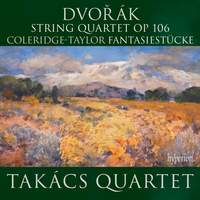Recording of the Week,
Coleridge-Taylor and Dvořák from the Takács Quartet

Today’s Recording of the Week is a snapshot of the year 1895, with a pair of works for string quartet composed in that year by Coleridge-Taylor and Dvořák. Both composers would have fruitful connections with the USA during their careers, though neither settled there; the Takács Quartet, on the other hand, have done just that, relocating from Budapest to Boulder, Colorado.
Coleridge-Taylor’s five Fantasiestücke are a set of clever, tuneful miniatures, with the music largely led by the first violin (Edward Dusinberre, originally from here in Leamington). This is particularly apparent in the triumphant syncopated motif in tenths that features prominently in the opening Prelude, with Dusinberre soaring above the rest of the texture.
Taking five with Tchaikovsky, and a barn-dance with Dvořák
The second piece’s innovative nature isn’t immediately obvious; inspired by the success of Tchaikovsky’s Pathétique, the young Coleridge-Taylor (still in the early stages of his studies with Stanford at London’s Royal College of Music) tried his hand at his own movement in 5/4, but where Tchaikovsky emulates a lilting waltz, Coleridge-Taylor chooses something much more stately and subtle in which the rhythmic asymmetry is far less obvious. If it’s possible to have a sarabande in 5/4, then this is it.

The Humoresque has more of the air of a foot-stomping dance than anything that might actually be called humorous per se (the occasional wry, Haydn-esque caesura notwithstanding) - and Coleridge-Taylor’s high opinion of Dvořák is abundantly clear. Not only is the movement’s title evocative of his own eight contributions to the genre, the music itself has a distinct air of Dvořák about it, with a bracing sense of minor-mode dynamism that the Takács lean into, giving it a real whirling feel.
Maintaining that sense of faint rusticity, the closing Dance makes use of exciting sforzando drones to set up its vigorous mood. Where other accounts of the Fantasiestücke have seemed almost embarrassed about digging into these, the Takács Quartet have no such qualms, unashamedly getting in touch with their inner accordionists.
Though the two main works on the album date from the same year, any comparison between them is unavoidably an unequal one - and indeed a poignant one, reminding us what a loss to music Coleridge-Taylor’s premature death was. His Fantasiestücke are early pieces, five gorgeously-crafted works full of youthful energy and brimming with the sprouting genius of an obviously gifted twenty-year-old composition student who, tragically, would never see forty.
Dvořák’s thirteenth quartet, meanwhile, is from the composer’s mature period in his mid-fifties, showing its vintage in its handling of large-scale musical paragraphs and chapters. The Takács establish a very different mood from the very opening bars - nothing obvious, just a sense that this is heavier music painted on a bigger canvas. There’s also perhaps a shade more grit in the bowing than in some other accounts of this quartet.
Dvořák looking back at what might have been?
The slow movement is particularly special; after an immensely beautiful opening section that culminates in the quartet evoking a heroic choral tutti (again, committing to the fortissimo more strongly than some, and very much respecting the climactic, forceful accents both here and throughout the movement), stormier minor-mode material intrudes and the movement moves back and forth between the two moods. I hesitate to ascribe too much autobiography to any work, even something as conventionally introspective as a string quartet, but the knowledge that Dvořák’s first love had died earlier that year may help illuminate the emotional tug-of-war that seems to be afoot here. Regardless, it’s one of his most moving and beautiful slow movements, and there’s something almost cathartic about its serene closing chords.

The final movement, too, opens reflectively - though the accelerando into Allegro con fuoco is not long in coming. An extended passage of slower, almost melancholy, material towards the end (including some characterful cadenza-like writing that gives viola Richard O'Neill a brief moment in the spotlight) is an unexpected but welcome detour; the closing pages see another emotional tussle, with Dvořák seemingly unable to decide until the very last minute whether the ruminative, placid material or the con fuoco should have the final say.
Despite both being for string quartet, both from the same year and indeed sharing a great many stylistic features, the Coleridge-Taylor and Dvořák pieces here are still as different as chalk and cheese; youthful energy contrasting with mature retrospection, perhaps. But as a diptych they work perfectly, and the Takács Quartet are equally at home in both.
As ever, this recording is available on CD and to download in a range of formats - but there’s good news for those of a streaming inclination, as I’m delighted to announce that it’s also among the first batch of highly-awaited Hyperion releases to come to the Presto streaming service, with the entire catalogue due to materialise over the coming months.
Takács Quartet
Available Formats: CD, MP3, FLAC, Hi-Res FLAC, Hi-Res+ FLAC



